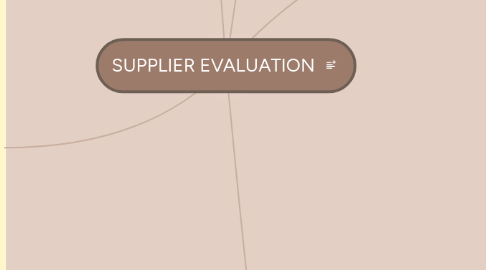
1. Improve competitiveness
1.1. By selecting the right suppliers
1.2. By finding the developing objects
2. Evaluation methods
2.1. Surveys & Questionnaires
2.1.1. Types
2.1.1.1. RFI surveys
2.1.1.2. Quality surveys
2.1.1.3. Supplier surveys
2.1.2. Important issues
2.1.2.1. Clarity of the questions
2.1.2.2. Time to complete
2.1.2.3. Timing of deployment
2.1.2.4. Survey length
2.1.2.5. Confidentiality
2.1.2.6. Team experience and capabilities
2.1.2.7. Communication strategy
2.1.2.8. Budget
2.1.2.9. Language
2.1.2.10. Cultural background
2.1.2.11. Compliance
2.2. Scorecards
2.3. Site visits
2.3.1. Suit to
2.3.1.1. Critical/strategic product or service
2.3.1.2. Suppliers represent high levels of spend
2.3.1.3. Sole-source, single-source suppliers
2.3.1.4. High switching costs
2.3.2. Brief visits
2.3.3. Specific business process area visits
2.4. Supplier assessment
2.4.1. Four levels
2.4.1.1. Product level
2.4.1.1.1. Improve product quality
2.4.1.2. Process level
2.4.1.2.1. Investigate production process
2.4.1.3. Quality assurance system level
2.4.1.3.1. Investigate supplier quality organization
2.4.1.3.2. SOP – Standard Operating Procedure
2.4.1.4. Company level
2.4.1.4.1. Financial aspects
2.4.1.4.2. Quality aspects
2.4.1.4.3. Management aspects
2.4.2. Two types
2.4.2.1. Subjective methods
2.4.2.1.1. Using personal judgments
2.4.2.2. Objective methods
2.4.2.2.1. Quantify supplier’s performance
2.4.3. Techniques & tools
2.4.3.1. Spreadsheets
2.4.3.1.1. Compare/asses quotations from suppliers
2.4.3.2. Qualitative assessment
2.4.3.2.1. Close business relationships
2.4.3.3. Vendor rating
2.4.3.3.1. Quantitative data
2.4.3.3.2. Measure price, quality & delivery reliability
2.4.3.3.3. Current suppliers
2.4.3.3.4. Standard time
2.4.3.4. Supplier audit
2.4.3.4.1. Scopes
2.4.3.4.2. Tasks
2.4.3.4.3. Types of suppliers
2.4.3.4.4. When
2.4.3.4.5. Requirements for suppliers
2.4.3.4.6. Audit process
2.4.3.5. Cost modeling
2.4.3.5.1. Specialists' visits
2.4.3.5.2. Production technology, product cost
3. Goals of supplier evaluation
3.1. Ensure the availability of potential suppliers
3.2. Measure and monitor supplier's performance
3.2.1. Reduce costs
3.2.2. Mitigate risks
3.2.3. Driving continuous improvement
3.3. Deepen the knowledge about each supplier
3.4. Assist with decision making
3.5. Highest priority to measure
4. Evaluation strategy
4.1. Suppliers segmentation
4.1.1. Kraljic’s portfolio model
4.1.1.1. Strategic suppliers
4.1.1.1.1. Performance evaluation.
4.1.1.2. Leverage suppliers
4.1.1.2.1. Financial impact
4.1.1.3. Bottleneck suppliers
4.1.1.3.1. Performance monitoring
4.1.1.4. Noncritical/commodity suppliers
4.1.1.4.1. Operational efficiency
4.1.2. Other ways
4.1.2.1. Supplier commitment matrix
4.1.2.1.1. Low commitment + Low actual commitment
4.1.2.1.2. Low commitment + High actual commitment
4.1.2.1.3. High commitment + Low actual commitment
4.1.2.1.4. High commitment + High actual commitment
4.1.2.2. Supplier characterization matrix - product development
4.1.2.2.1. Low spend + High design input
4.1.2.2.2. Low spend + Low design input
4.1.2.2.3. High spend + High design input
4.1.2.2.4. High spend + Low design input
4.1.2.3. Supplier characterization matrix - spend
4.1.2.3.1. Low commitment + High risk
4.1.2.3.2. Low commitment + Low risk
4.1.2.3.3. High commitment + High risk
4.1.2.3.4. High commitment + Low risk
4.2. Supplier performance management actions
4.2.1. Strategic segment
4.2.1.1. Highest priority to measure
4.2.1.2. Strategic value
4.2.1.3. Relationship quality
4.2.1.4. Contribute to business
4.2.1.5. Emphasis on continuous improvement
4.2.2. Collaborative segment
4.2.2.1. Important to measure
4.2.2.2. Operational performance measures
4.2.2.3. Financial measures
4.2.2.4. Encourage continuous improvement
4.2.2.5. Relationship quality
4.2.3. Custom segment
4.2.3.1. Operational performance measures
4.2.3.2. Service level
4.2.3.3. Relationship quality
4.2.3.4. Reliability - avoid surprises
4.2.4. Commodity segment
4.2.4.1. Lowest priority to measure
4.2.4.2. Focus on operational performance basics
4.2.4.3. Measure internal stakeholder satisfaction
5. Criteria for evaluation
5.1. Lagging indicators
5.1.1. Reactive approach
5.1.2. Operational results
5.1.3. Used after certain activities have occurred
5.1.4. Ex: Accounts payable cycle, quality metrics...
5.2. Leading indicators
5.2.1. Proactive approach
5.2.2. Value attributes
5.2.3. Predict/drive bottom line performance results.
5.2.4. Ex: Supplier performance problems, customer satisfaction...
5.3. Quantitative
5.3.1. Objective metrics
5.3.2. Based on empirically gathered ”hard” data
5.3.3. Ex: Transportation costs, scrap and rework...
5.4. Qualitative
5.4.1. Subjective metrics
5.4.2. KPIs - Key Performance Indicators
5.4.3. Based upon human opinion or perception
5.4.4. Ex: Customer complaints and satisfaction...
5.5. Performance expectation
5.5.1. A statement of a business practice, process, policy, results from
5.5.1.1. Supplier’s performance
5.5.1.2. Supplier's behavior
5.5.2. Look forward
5.5.3. Development methods
5.5.3.1. Strategy deployment
5.5.3.1.1. Corporate goals
5.5.3.1.2. Corporate strategies
5.5.3.1.3. Procurement strategy.
5.5.3.2. Other sources
5.5.3.2.1. Business models
5.5.3.2.2. Value stream mapping
5.5.3.2.3. Business drivers
